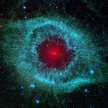You May Find Them Interesting
Here are five of my short-form stories, enjoy.

British spelling.
<><><>
1/5

Comets are objects in our solar system made of dust, rocks, and ice. They orbit the Sun in highly elliptical (oval-shaped) paths.
As they get closer to the sun, they warm up and release gases and other debris. This outgassing produces a coma, sometimes called a tail.
In 1986, my two young children and I watched the most famous short-period comet, Halley, as it made its closest approach to the Sun on its long journey through space.
There's a chance my children will see it again. In 2023, in an area farther away than the most distant planet, Neptune, it will turn around and start on that long trek back towards the sun, arriving here in 2061.
Depending on when you were born, some people will see Comet Halley twice; I saw it once but will never see it again.
<><><>
2/5

The Genetic Ties That Bind Us.
You, me, and every other human alive today share about 99.9% of the same DNA (deoxyribonucleic acid).
That slight difference of 0.1% is what makes each of us unique.
Chimpanzees are our closest relatives in the animal kingdom, sharing almost 99% of our DNA.
Surprisingly, the common slug shares 70% of our DNA. We even share 50% of our DNA with one of our most popular fruits, bananas. Yes, every living organism on our planet is related.
It is widely believed that all living organisms have evolved from a common progenitor through mutations in their DNA.
The result of this 3.5 billion-year-old process is the biodiversity of species we see worldwide today.
<><><>
3/5

The Most Distant Man-Made Object.
Voyager 1 continues to travel through space at over 60,000 kilometres per hour and is the most distant man-made object that has left our planet.
Voyager's speed seems very fast, but let's put it into perspective.
Imagine if Voyager 1 were to change direction and travel towards Sagittarius A*, the black hole at the centre of our galaxy, the Milky Way.
That epic journey would take roughly 450 million years.
As of June 2024, that small probe is over 24 billion kilometres from the Earth.
Chances are that Voyager 1 will still be travelling through space when the last human dies.
I wonder if another intelligent life form will discover our tiny probe.
<><><>
4/5

Gazing up at the Night Sky.
When viewing the night sky, you're looking back in time.
Reflected light from the Moon left its surface 1.3 seconds before it made contact with your eyes.
The Sun is about 150 million kilometres from the Earth, so light leaving the Sun takes over eight minutes to reach us. You're seeing the Sun as it was just over eight minutes ago.
Now, take the farthest object that you can see with your own eyes.
The light from the Andromeda Galaxy that you are seeing now left on its long journey 2.5 million years ago, so you are seeing the galaxy as it was way back then.
From the surface of our planet, we can see roughly 2,500 stars on a clear night.
By the way, the speed of light is 1,080 million kilometres per hour.
<><><>
5/5

There Was a Day Without a Yesterday.
The universe burst into existence 13.8 billion years ago, if that is correct then the above statement must be true.
On the day of your birth, there was a yesterday, and on the day you die, there will have been a yesterday.
It is the same story for all the estimated 117 billion humans that have ever lived.
Before the Big Bang, time and space never existed; they both started at the universe’s birth.
The universe has been expanding and ageing ever since it was created.
Astronomers have calculated that the universe is over 90 billion light years in diameter.
To put that calculation into perspective, a light-year or the distance light travels in a year, is equivalent to 9.46 trillion kilometres or 5.87 trillion miles.
A trillion is 1 followed by 12 zeros.
The end.
<><><>
About the Creator
Unravelling the Universe
We can only imagine what our early ancestors thought as they gazed up at the night sky—were they curious about what the heavens had to hide?
Enjoyed the story? Support the Creator.
Subscribe for free to receive all their stories in your feed. You could also pledge your support or give them a one-off tip, letting them know you appreciate their work.






Comments (2)
I enjoyed reading all these stories! Loved them all!
Great effort. Liked it.